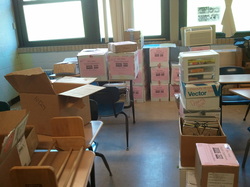 It's my third year of teaching--and my third building. My first year of teaching was spent in a neighboring county: an experience I never will forget. Yet...I've just entered my third building in three years.
The old school needed repair. It was outdated, the heating was unreliable, the paint a nice shade of 1970, the windows broken to the point they would guillotine when oppened. Not to mention we did not have central air and, being a "year-round" school (the technical name is "balanced calendar"), that meant we began August 1 and ended June 8 or later. It was time for a change, and that change came with the building of a brand new facility, one actually split into a middle school AND a high school like it was supposed to be. Left, boxes labeled and ready for the move.
The weeks before Christmas were spent packing up our rooms from top to bottom. This period of time may have been one of the most taxing I've seen for my nerves: other colleagues were experiencing this, too.
Initially, we should have been in the new school in 2011, I believe, at Christmas. The building was two years later, over budget, and our move-in dates were continually changing.
It was worth the wait.
Below, image of the old classroom.
Now a true 7 - 12 school, our building is split into a Middle School and High School wing, complete with an auditorium (we did not have one before); teachers' lounges and workrooms for the first time ever; breathtaking science labs; more parking; an auxillary gym; and a "big gym" for sporting events. Additionally, we have some of the most state-of-the-art technology and heating/cooling in existence. Below, view of the classroom from back right corner. 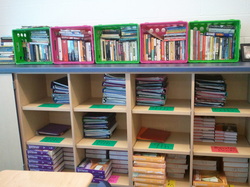 As a teacher, this is what the new school has brought me: more space for my 6'8" sophomore; larger desks for the 230-lb linemen; the addtion of a nine-period day and, in response to this, a Theatre I elective (which I am teaching); and 100% more storage in the classrooms. I am able to feel far more professional than I have yet felt to date. Left, view of the storage in my classroom (SSR books in the crates, binders by period below, books bottom):
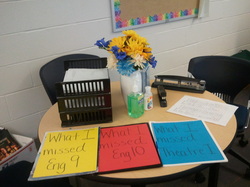 The students took a little bit of time to adjust: many of our students respond poorly to change, very much appreciative of that which is "comfortable". Within about a week, however, the students were more excited than nervous about their new school. Left, Student Station complete with missing work folders, miscellaneous supplies, and turn-it-trays.
 Left, indoor walking track near completion stage. The walking track is now operational and I use it frequently!
 Left, auxillary gym.
 Left, "big gym". The lines are now painted. I will post a picture of it in its completed state soon!
One of the centers of conversation at the Teacher Leadership Institute I attended in West Virginia this year had this focus: the R's of learning are changing. Instead of the old "reading, 'riting, and 'rithmetic" we before associated with the R's of learning, we must now focus on developing RELATIONSHIPS, making what we teach RELEVANT to the digital/modern learner, and applying more RIGOR to our curriculum.
Since I started teaching two years ago (this is my third year), I knew I had to develop a relationship with my students in order to "get them to work" for me. I especially knew during my first year that I had to make a connection early: my first period of the day involved teaching a small classroom of mostly at-risk boys. I've often reflected on how I've gotten to know students--having conversations with them in the halls, attending sporting invents, responding to their comments--and, though I've been happy with the relationships I created before, this year I was determined to create an even stronger relationship than I had in prior classes.
To get to know my students at the beginning of this year, I had them complete a writing survey. This gave me an automatic springboard to begin starting a relationship with my new students and deepening the relationship I have with my current sophomores. During TLI, a teacher from another school in my county suggested using "tweeting" as a means of completing an exit slip. Her idea was positively brilliant, and has become a foundation for getting to know my students.
So how do they "tweet", exactly, in the classroom. For starters, none of this is done online as one would initially think: instead, we apply the CONCEPTS of Twitter in our classroom.
Before I continue, I would like to say now that in no way am I giving myself any credit at all for these concepts. I appreciate Twitter's evolution as a company, and in no way would I give myself credit for how we do tweet in our English 9 and English 10 classrooms. I am always sure to let students know this, too. I make a point that we are using the concepts for educational purposes and that I am in no way trying to take ownership of these applications.
Here's how it works: the very first week of school, I had all students create a username, making it very clear that every tweet posted would be public and must be appropriate. The tweeting is carried out in a series of thematic journals topically assigned based on the writing surveys completed. Students write for a preset amount of time (usually between 5 - 10 minutes) in these thematic journals using their user names twice a week on two different topics. During the week they may respond to other classmates' journal entries using the "@" sign, and signing with their own username, just as Twitter originally developed. A response, for example, would look like the following "@nXgWVteacher 8/14/12 (comments) -username". So far, this strategy's success is immeasurable: on more than one occasion I have had students ask "Are we tweeting today?" and this is only the second full week of school! I rarely see a student stop writing before the bell sounds for the end of the journaling, and they are daily eager to respond to each others' responses. Additionally, they are fascinated by the concept of "not always knowing" who it is they are responding to. I, of course, have usernames documented for personal reference to formatively grade students' responses and to determine what students are not handling the tweeting appropriately.
You may be thinking, how do you know if what they are writing is appropriate? I read ALL entries and respond to EVERY student weekly. I go out of my way to be sure I tweet back to another student in order to continue developing relationships. If you're not willing stay after hours to respond to students, this process is not for you. Last week, I spent at least 5 hours reading and responding to my students--personally, I am not complaining, but you must acknowledge that using this strategy will create work for the teacher as well if done properly. It's also important to note that my students are THRILLED to see what it is I've written back. The few times I've caught people talking when they were supposed to be writing during journaling, they were most often excited about another student's response or whispering to each other "What did Mrs. H tweet back to you?" Much like with silent reading, I also journal WITH the students during the allotted time rather than doing other things such as grading papers or organizing for the next class. This strategy works, folks. I can already get so much out of my students after only a week and a half than I ever expected, and half of my students I've never had before. I can't even imagine how far we will develop as a community by Christmas, and I cannot even fathom how far we will go by the end of the school year.
So far, I've only had two instances out of roughly 110 entries when students have been inapproriate. The first was a situation where, though I'm sure the boys were "poking fun" at one another in a playful manner, they were being what I viewed as extremely rude to each other, explaining to one another that "their writing looked like their four-year-old-sister's handwriting" or that "their answer was stupid." The other instance was a situation where a student wrote in a response "LMFBO", which, as most of us know, includes a letter that represents the f-word. Both of these students received a warning from me in the actual thematic journal they had comitted the act in and the warning was highlighted so that all other students could see what they had done wrong. Mind you, their usernames did keep them anonymous, but every student is able to see that someone did something wrong in the journals--and this method worked. I've not had a problem since (as of yet...I still have to read the 9th grade entries) with students writing something inappropriate.
Tweeting is also used in my classroom at the end of the week. Last week, students were given a "conversation bubble" where they wrote a response to one of the following questions: 1) What did you learn this week? 2) What did you like in this class this week? or 3) What did you find amusing in this class. I then posted these tweets on my chalkboard so all other students could see what their classmates were writing. A heading appeared at the top of the bubbles that stated "Trending Now", and below this label were a series of hashtags representing topics most commonly written about in the Tweets-of-the-Week. Again, my students are EXCITED about tweeting these things. I received more feedback on these bubbles than I ever did last year when I asked students simply to "write a paragraph" about one of those questions. The tweeting is more informal, allows them to remain anonymous, and is relevant to them because of the method they are responding.
Below are some sample tweets-of-the-week from my students. 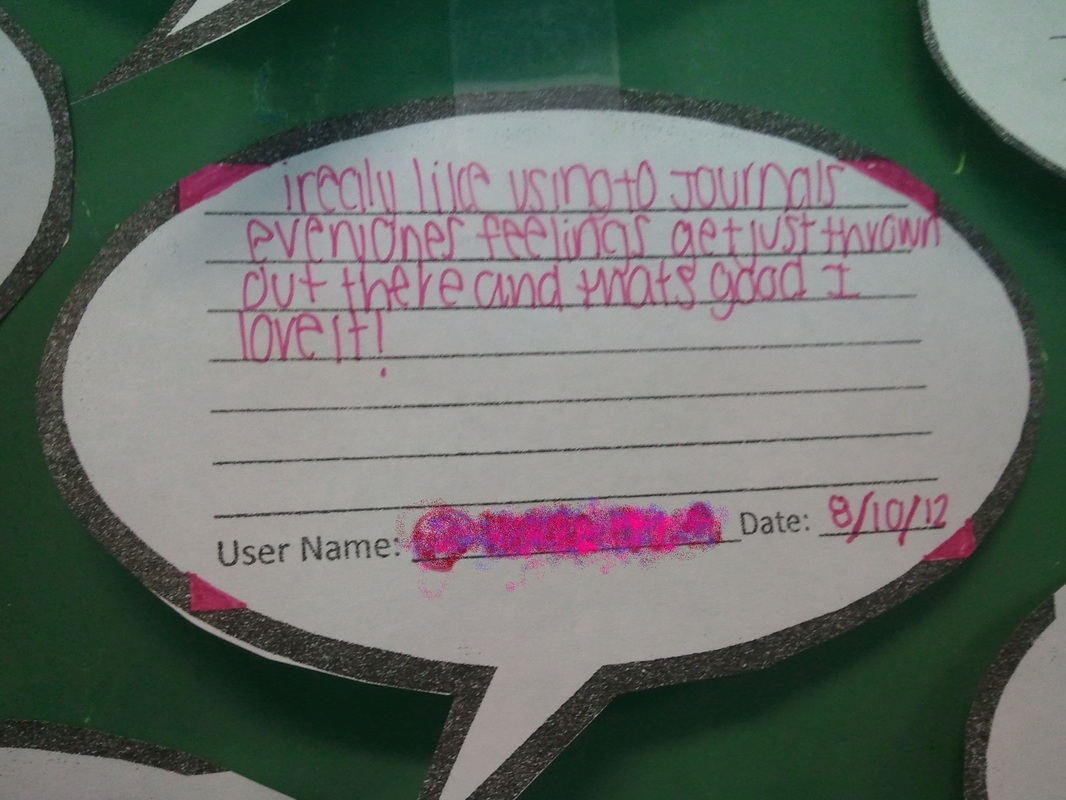 This tweet is from a young lady I know (from having her last year) struggles with peers. Last year I recall an instance where her peers picked on her and spread rumors about her. For her, the thematic journals are a method of "getting her feelings out there". If I can help her manage stress/worries she is having in school, I've accomplished something. 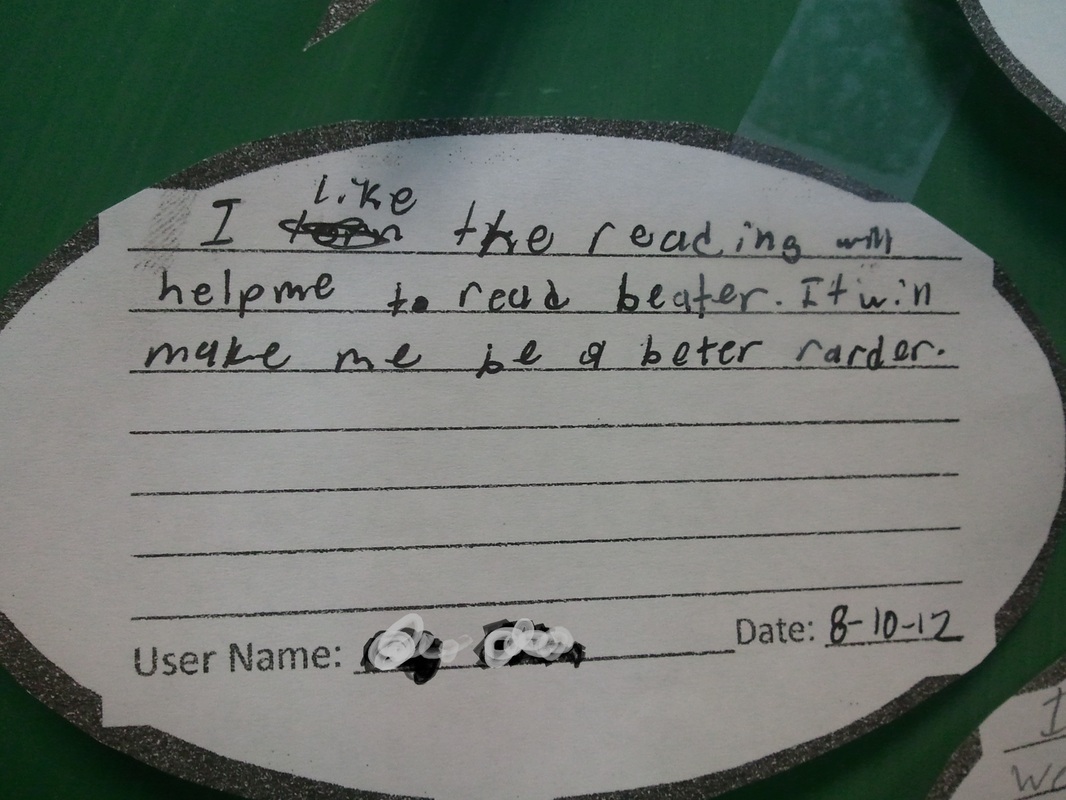 This is a tweet from one of my lower-level students just now getting back into reading because of the time we spend doing Sustained Silent Reading. If you notice, he has made a very mature prediction: reading silently will help him become a better reader. That is the goal of SSR, so if this is his goal, I'm confident his reading skills will increase! 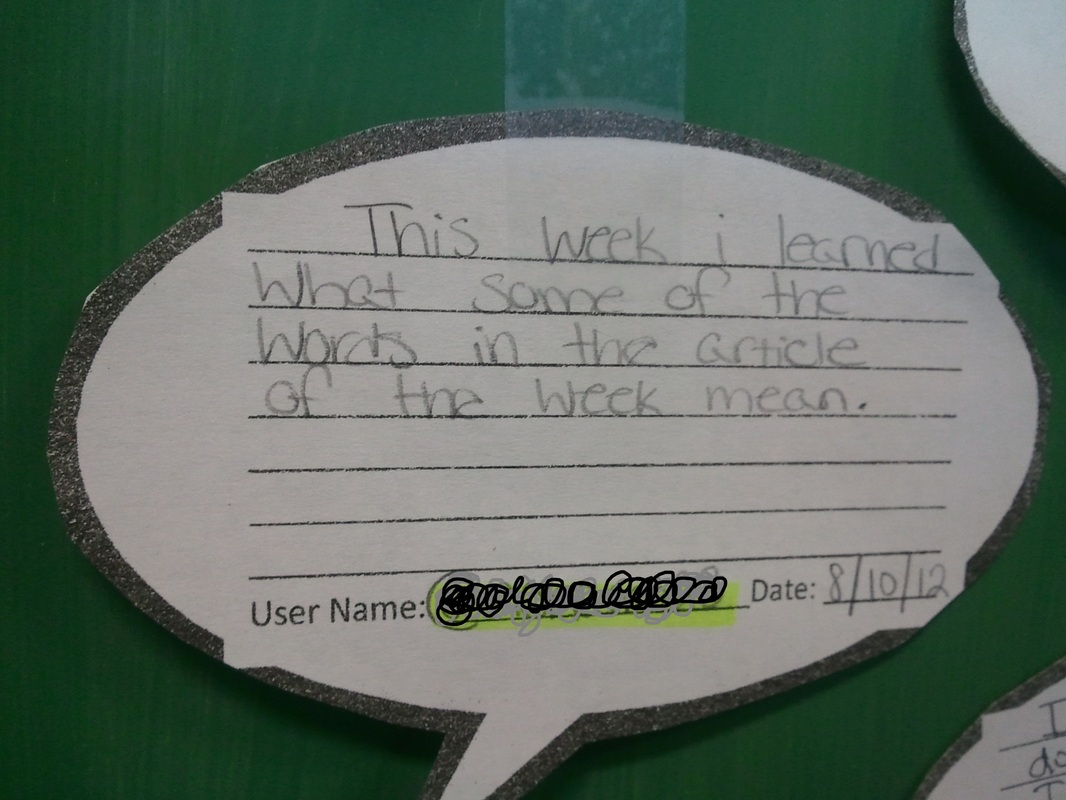 As part of annotating our AOW's, we explore what some of the upper-level vocabulary in the article may mean using context clues, a friend as a resource, prior knowledge, roots and prefixes, or, if we must, the dictionary. 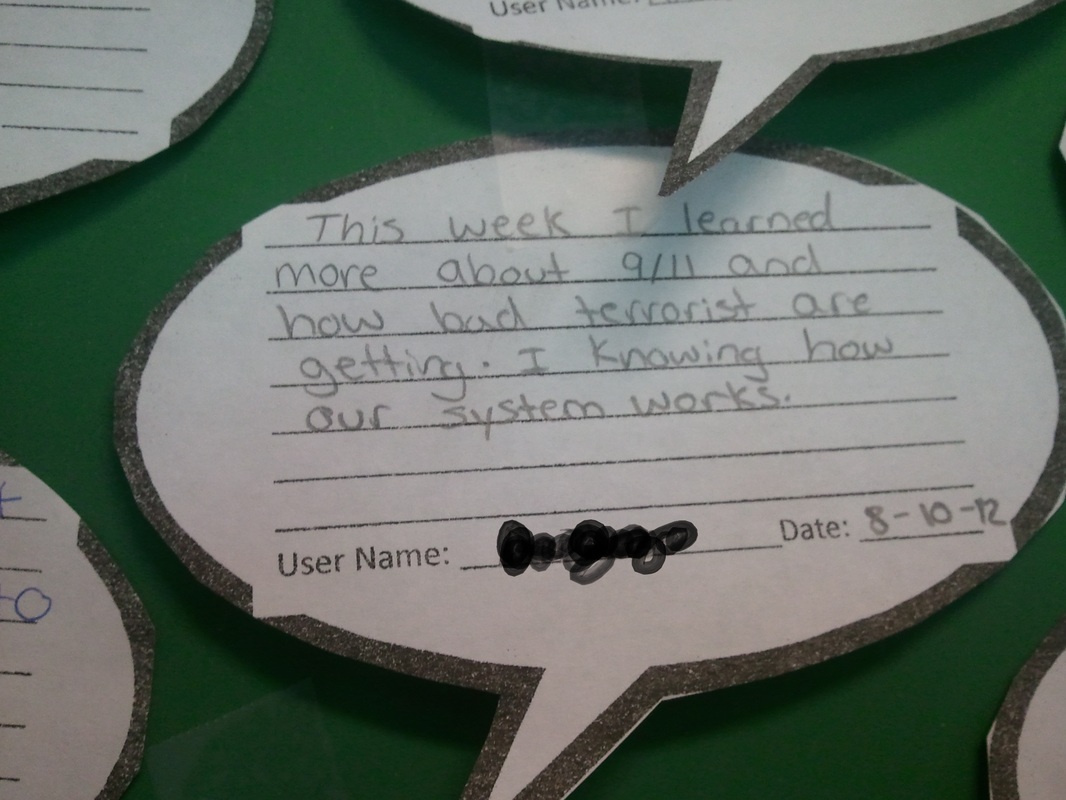 Our AOW this week concerned what kinds of criminals are held at Guantanamo Bay. The article paid close focus to the fact many of the detainees had connections to Al Qaeda.
This will be a very short entry.
In both my 9th and 10th Grade English classes, students began Articles of the Week (from here on referred to as AOWs). Our AOWs typically will relate to the unit we are about to study. Each AOW is also an informational text, a type of literature we are now expected to expose students to as much as possible. The title of the 9th Grade article this week is “New President will Face Test on Detainees” (from the last Presidential election) and the title of the 10th Grade article is “Think Congress is Sophomoric? A Study Says You’re Right”. Both articles can be found in the archived AOWs at kellygallagher.org.
I chose these two articles to teach annotation for a few reasons. For one, they are mostly political in nature. My knowledge of politics is limited, and I wanted to model to students that there are many terms I do not know when reading certain topics. In short, I knew that modeling annotating a political text could potentially motivate my poor readers to understand that even I could be labled a "poor" reader at times if I am unfamiliar with the content. The second reason I chose these two particular articles is because we will eventually be reading speeches and other informational texts, some of which may or may not have heavy political undertones.
How the process works: - All students receive the article on Monday. The are expected to archive their AOWs in that particular section of our binders.
- We work through annotating the article together as many days as it takes (I actually state my thoughts and confusions aloud as I read, and students "mark up" their articles exactly like mine to begin the habit of annotating
- A response to the article is due at the end of the week. We will complete the responses together at first, but eventually all parts of the AOW will be done as homework. My aim is for this to be a regular homework assignment by September.
Today, the students did a pretty good job of annotating with me. I did preface the lesson by telling them learning to follow my thought processes may be confusing at times, but that they would eventually understand how important it is to be an "active" reader. We should finish annotating our articles tomorrow.
Students at my school began Wednesday, August 1st. The first day of school was typical: teaching procedures, going over the syllabus, explaining expectations--the usual housekeeping at the beginning of the year.
Yesterday, I had my students complete a Writing Interests Survey. Categories on the survey included things such as sports, personal, outdoors, and fantasy/supernatural. Sub-categories were Professional Sports, College Sports, High School Sports (sports); Losses, Relationships, Experiences (personal); Mythological Creatures, Dragons and Monsters, Vampires and Werewolves (fantasy/supernatural). The inspiration behind evaluating what students are intersted in writing is to inspire them to write more and to write often. Two days a week, students will write in thematic journals based on their writing surveys in order to inspire them to write and write often. This process will (hopefully) make it desirable for the individual student to try his or her best in writing. I will post the tallies of specific classes at a later date so you can see what students in rural West Virginia are interested in.
On our school's block days and Fridays, they will engage in Sustained Silent Reading: reading for pleasure for a designated part of the class period. The idea behind this design is to reinstate a desire to read in the "digital" student.
Regarding the NxG Standards: Today, students worked in their "quads" (desks grouped in fours) to evaluate the new WV NxG Reading Standards (though we could take class time to study the writing, speaking/listening, and language standards as well, the reasoning behind this activity was to expose them to the langauge. As an ELA teacher, you may decide to have your students evaluate ALL standards, but I will tell you this: it took approximately 30 minutes for my students to read through and dissect only the Reading standards and an additional 15 minutes to report to the large group. It is up to you how much class time you would want to take on this activity). Students were instructed to read the standards together and note the following things on a piece of paper folded into a trifold: what they noticed about the standards, what interested/excited them about the standards, and what worried them about the new standards. Though some of them gave humorous answers, here are some of the things my students came up with:
What students noticed:
1) Use of the word "analyze" in almost every standard
2) All of the standards have a code
3) The standards use a lot of "big words" (which I explained to them was mostly academic vocabulary, to be studied in our classroom
4) Many words are repeated, such as "determine", "evaluate", "cite", and "textual evidence"
5) We will be reading informational texts.
What students found interesting:
1) It looks like we'll be reading about characters and main ideas
2) We will be reading informational texts
What worries students:
1) It seems like all we will do is analyze.
2) We don't understand some of the language in the standards, so how will we "get" what to do?
3) There's a lot to learn
If you think about it, considering these were ninth and tenth grade students
(so, roughly ages 14 - 16), some of their responses were quite respectable.
Beginning Monday, my students will begin Kelly Gallagher's Article of the Week (go to kellygallagher.org and explore his archives: it's a great resource for informational texts--all free and printable) and, if time permits, they will complete a Book Pass (to be explained in a later blog). The Book Pass will move to Tuesday if the AOW takes the full period on Monday.
Today we presented WV's NxG Standards to a small audience for county training. When we saw the numbers yesterday, we were discouraged: today, we only had two individuals attend training: one freshmen English teacher from our city school and one gifted instructor. Though slightly bothered by the low turn out, we still ended up having a very healthy discussionn regarding the standards during the workshop.
To begin, we had our participants try writing a six-word memoir as an introduction. The goal of this exercise is to, in six words or less, describe yourself. It's a strategy any ELA (or other content area) teacher could use as an ice breaker at the beginning of the school year or semester to get to know his or her students. And, approaching introductions in this manner causes students to really think about what words they could use: after all, they only can use six. Throughout the rest of the morning, we had our two participants examine each of the four standards (Reading, Writing, Speaking and Listening, Language) independently and then reflect back to the larger group. After exploring standards both of our participants came of with questions my colleagues and I had come up with when we attended the state training for NxG/Common Core Standards a few weeks ago. The following two questions were asked:- If we implement these new standards in detail this year with the Smarter Balanced Assessment in mind, how will that affect our WESTEST 2 scores? Will we be preparing the students enough for this test?
- With the shifts in recommended texts by grade level, what do we do if a text is taught in multiple grade levels?
Eventually I will publish an entry explaining the Smarter Balanced Assessement to be taken in the 2014-2015 school year, but the answer to this question really is quite simple: regardless of the depth in which you apply the new standards into the classroom, you will still be preparing the student for WESTEST 2. Though the new standards are, indeed, different, they cover much of the same material as the old CSOs but cover them instead in a much more in-depth, detailed approach. The other two presenters and I (as well as representatives from the state) are confident that if you are teaching based on the new standards, you will be preparing your students for WESTEST 2.
Many ELA teachers in WV have also noticed the shift in recommended texts for grade levels. Macbeth, for example, before taught in 11th or 12th grade, has become a recommended text for 9th grade. Romeo and Juliet is another text that has "shifted": it is now recommended that Romeo and Juliet be taught in 8th grade instead of ninth. My colleagues and I really had two answers for this: 1) You could accept that some teachers will want to stick to teaching a certain text in the grade level "it has always been taught" and teach a work comparable to such. Alternatively, a teacher of 9th grade could 2) teach excerpts from the initial text rather than the whole text. The example I cam up with was to teach Macbeth's "dagger speech" and then link it to a supplementary text with a similar theme or purpose.
During afternoon session we introduced our participants to the Performance Tasks the mirror what the Smarter Balanced Assessment's Performance Task/Constructive Response questions will entail and, like us, the participants realized a shift in instruciton must occur for students to be successful when taking the Smarter Balanced Assessment in 2014-2015.
Tomorrow, my colleagues and I decided to give teachers time to plan and collaborate, since collaboration is a HUGE part of the new standards. We will first introduce them to model units on the WVDE state site (which I can link to in the next entry) and then the freshmen teachers from both schools (me, the other presenter, and our participant) will begin outlining a 3-6 week unit plan. The goal is that students at the rural school (where I work) and the city school (where the two of them teach) could be (potentially) teaching nearly the same thing at similar times.
Overall, it was a very successful first day of workshopping: I'm anxious to get together with our participants tomorrow and continue to "put our heads together"...
Because that's exactly what this is: an opportunity for you, as a fellow educator, to put my practices under the microscope, ask me questions, watch my journey with NxG and Common Core, and to help you understand that you're not the only teacher out there worried about her potential success (or failure) with "New Education." This is our opportunity as educators to discuss what works with one may not work with another or what works well in general. Why not create a such a resource? I'm excited to be that "url".
Later, I intend to post about the purpose (goal) of Common Core. Most of you out there have already been exposed to what exactly its intentions are, but I've always learned it's best to start from the beginning.
Topics to be discussed in the next entry:- How the NxG/Common Core movement can help the West Virginia Student
- The ability for this educational movement to empower
- The role of the teacher with NxG/Common Core
- States that have moved to Common Core
- How this is changing education
|






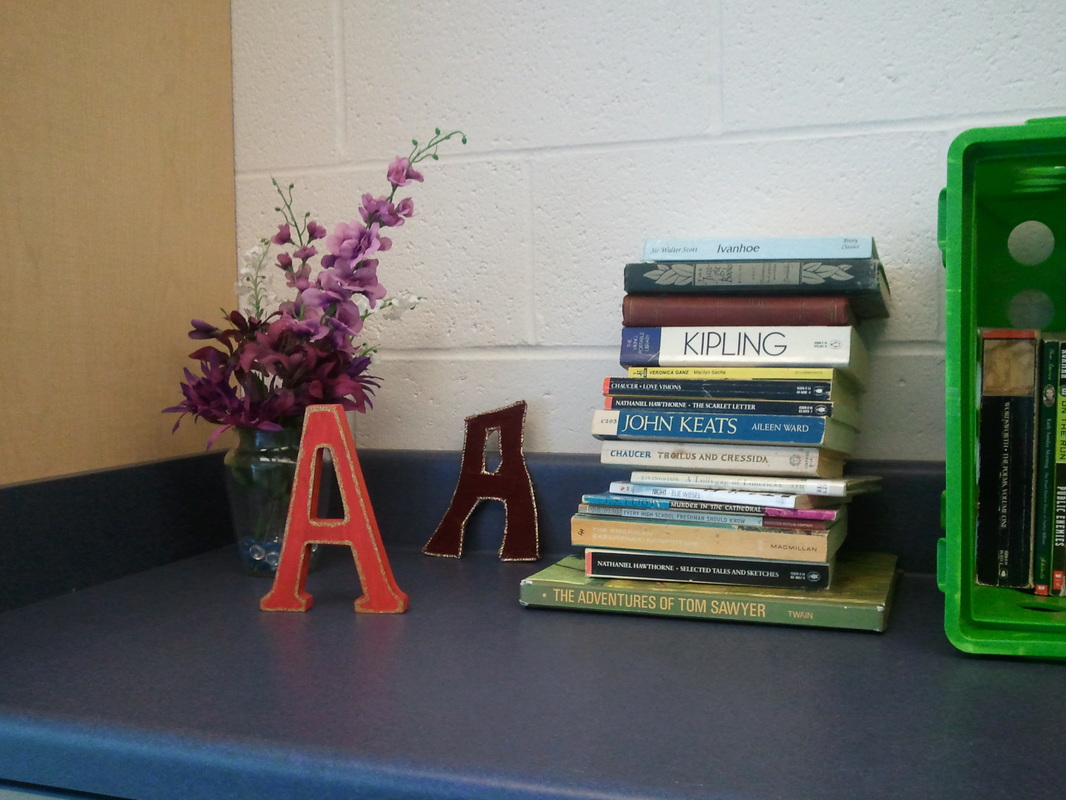
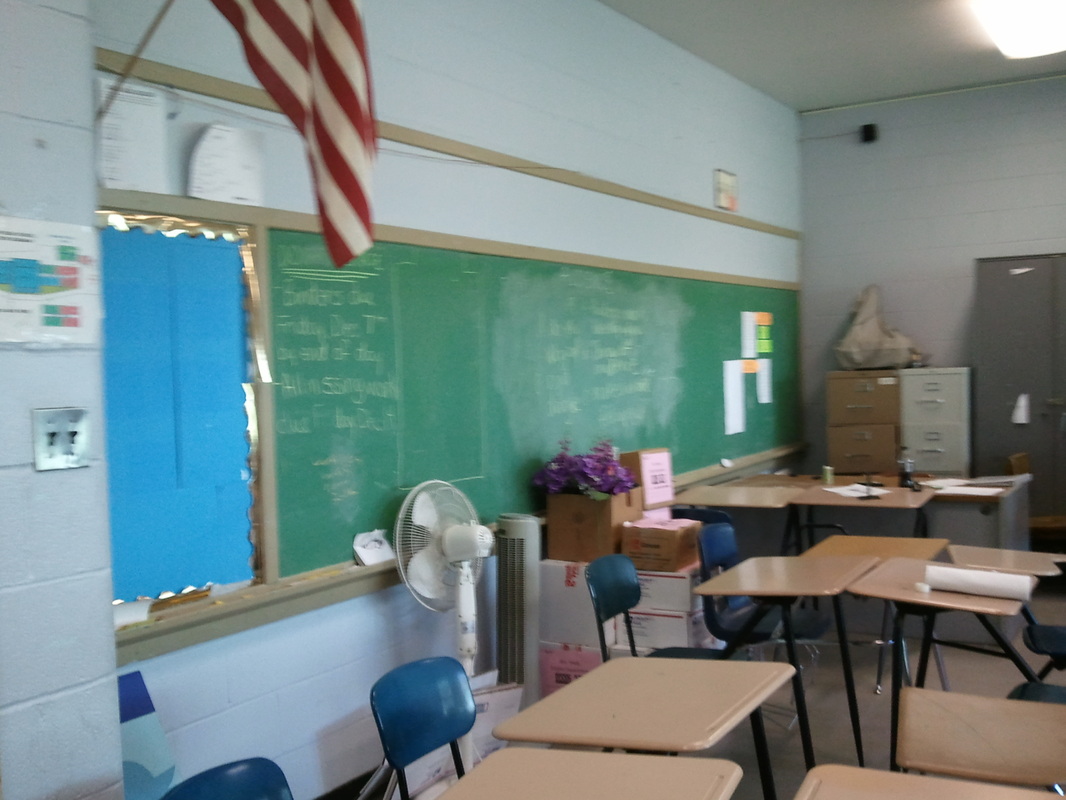
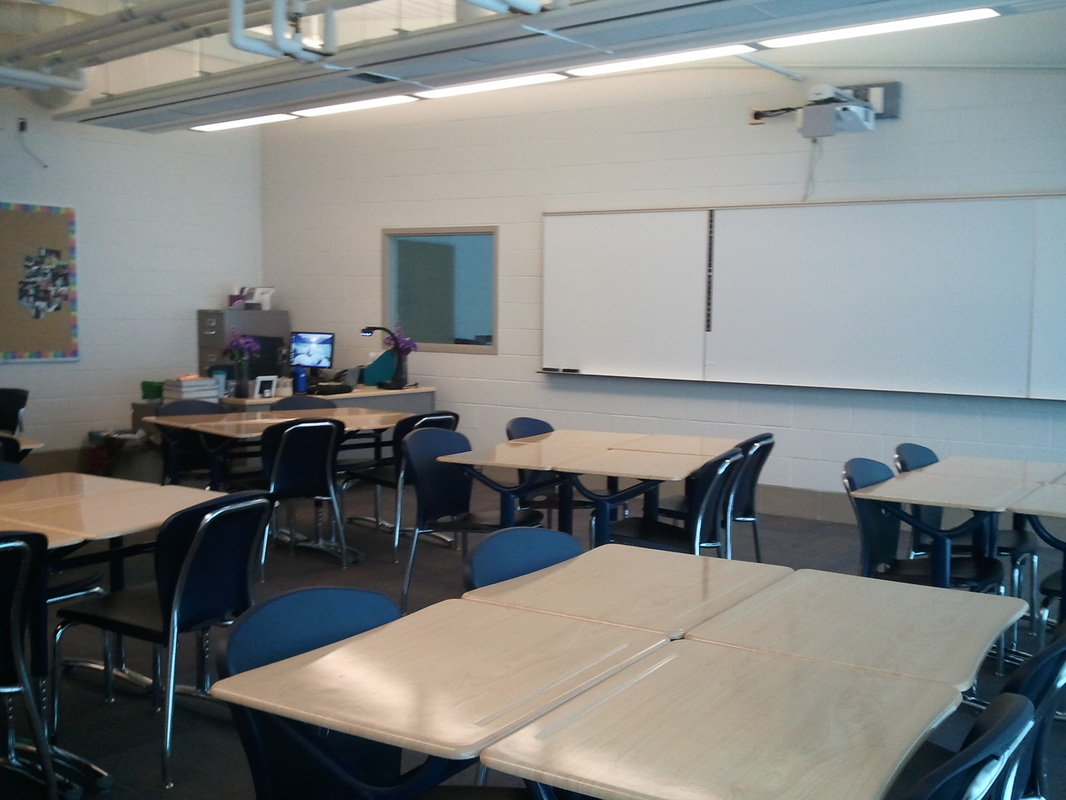




 RSS Feed
RSS Feed